AnimeGAN - Deep Convolutional Generative Adverserial Network
PyTorch implementation of DCGAN introduced in the paper: Unsupervised Representation Learning with Deep Convolutional Generative Adversarial Networks, Alec Radford, Luke Metz, Soumith Chintala.
Abstract
In recent years, supervised learning with convolutional networks (CNNs) has seen huge adoption in computer vision applications. Comparatively, unsupervised learning with CNNs has received less attention. In this work we hope to help bridge the gap between the success of CNNs for supervised learning and unsupervised learning. We introduce a class of CNNs called deep convolutional generative adversarial networks (DCGANs), that have certain architectural constraints, and demonstrate that they are a strong candidate for unsupervised learning. Training on various image datasets, we show convincing evidence that our deep convolutional adversarial pair learns a hierarchy of representations from object parts to scenes in both the generator and discriminator. Additionally, we use the learned features for novel tasks - demonstrating their applicability as general image representations..
Generator architecture of DCGAN
Directory Structre
.
├── assets
├── data
├── docs
├── logs
├── pipelines
├── research
├── src
│ ├── Data.py
│ └── model.py
├── tests
├── weights
├── LICENSE
├── README.md
├── requirements.txt
└── train.py
Run Training
python train.py \
--wandbkey={{WANDB KEY}} \
--projectname=AnimeGAN \
--wandbentity={{WANDB USERNAME}} \
--tensorboard=True \
--dataset=anime \
--kaggle_user={{KAGGLE USERNAME}} \
--kaggle_key={{KAGGLE API KEY}} \
--batch_size=32 \
--epoch=5 \
--load_checkpoints=True \
References
- Alec Radford, Luke Metz, Soumith Chintala. Unsupervised representation learning with deep convolutional generative adversarial networks.[arxiv]
- Ian Goodfellow, Jean Pouget-Abadie, Mehdi Mirza, Bing Xu, David Warde-Farley, Sherjil Ozair, Aaron Courville, Yoshua Bengio. Generative adversarial nets. NIPS 2014 [arxiv]
- Ian Goodfellow. Tutorial: Generative Adversarial Networks. NIPS 2016 [arxiv]
- DCGAN Tutorial. [https://pytorch.org/tutorials/beginner/dcgan_faces_tutorial.html]
- PyTorch Docs. [https://pytorch.org/docs/stable/index.html]











![[ICLR 2021, Spotlight] Large Scale Image Completion via Co-Modulated Generative Adversarial Networks](https://github.com/zsyzzsoft/co-mod-gan/raw/master/imgs/demo.gif)


